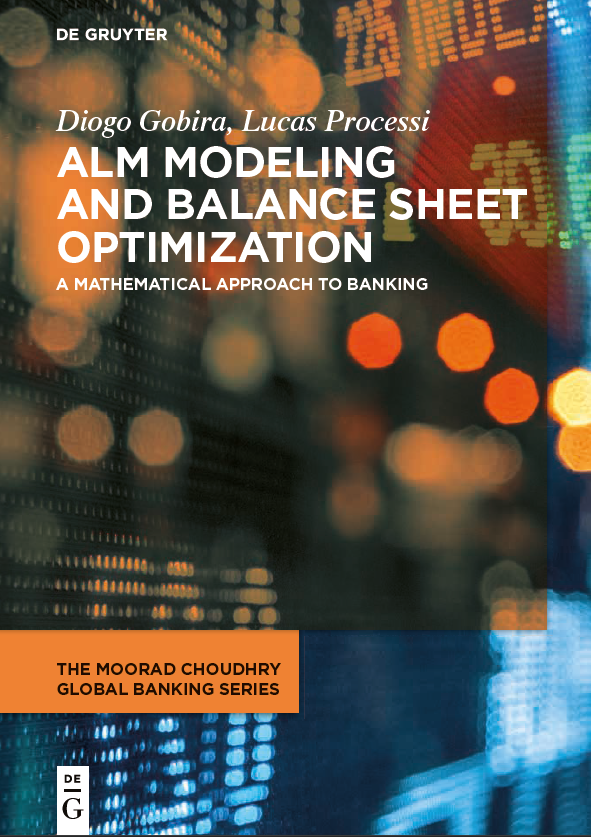Power your business
ALM & Balance Sheet Optimization
Financial Risk Academy is a company that helps financial institutions to optimize their balance sheets using dynamic programming and machine learning models. We also provide online training and consulting on ALM, FTP and Balance Sheet Optimization. Discover our cutting-edge technology and its benefits!
What we do?
Who are we?
Lucas Processi
Lucas Processi is an engineer and financial expert with a passion for market risk management and pricing of financial instruments. With a Bachelor’s degree in Production Engineering from the Federal Fluminense University (UFF) and a Master’s degree in Economics and Finance from the Getulio Vargas Foundation (FGV), Lucas is a market risk manager at the Brazilian National Development Bank (BNDES) and one of the founders of the Financial Risk Academy, where he shares his expertise in quantitative finance and programming with students and professionals alike. Additionally, his experience in the banking industry has enabled him to be a consultant in robo-advisors development, mathematical programming, ALM, and balance sheet optimization.
Diogo Gobira
Diogo Gobira is a skilled finance professional and entrepreneur with a strong background in quantitative risk management and mathematical finance. He holds a Master of Science degree in Mathematical Finance from the Institute for Pure and Applied Mathematics (IMPA), and has worked as a Market Risk and Quantitative Modelling Manager at BNDES (Brazilian National Development Bank). Diogo is proficient in a range of technical areas, including programming, databases, derivatives pricing, portfolio optimization, integrated risk management, IRRBB, FTP, stress testing, and balance sheet optimization. Diogo is also a co-founder of Financial Risk Academy, a company specializing in the development of balance sheet optimization models and advanced training and consulting in quantitative finance.
Assets Liabilities Management Training
Building an ALM & Balance Sheet Optimization Model
A course by the authors of "ALM Modeling and Balance Sheet Optimization - A Mathematical Approach To Banking", a book in The Moorad Choudhry Global Banking Series.
In this training, you'll learn to build a balance sheet optimization model using stochastic dynamic programming. This comprehensive course covers everything from data layers to decision variables, business and regulatory constraints, objective functions, modeling strategies, solving techniques, debugging, and reporting. Unique in the market, this online training provides cutting-edge tools to optimize your bank's performance, offering invaluable insights and skills for effective implementation of liquidity management and capital optimization tasks, financial statement and funding mix projections, funding and hedging instrument-level prescriptions, and more.
Course Objectives
Strategic Asset-Liability Management (ALM) can improve banks performance, but its implementation is far from trivial. This advanced program will teach you how to create a balance optimization model using dynamic programming and showcase its power with various concrete examples in liquidity management and capital optimization tasks, financial statement and funding mix projections, funding and hedging instrument-level prescriptions, and more.
Start Studying Today!
Course Syllabus
Week 1: Introduction
We begin the course by contextualizing the role of a modern treasury in banks and explaining how the imperatives of the Strategic ALM concept naturally emerge as a response to the problems of lack of coordination between assets and liabilities. Finally, we discuss how Mathematical Optimization can assist in the practical implementation of such concepts.
Week 2: ALM Model Architecture
In this module, we take a first overview exploring the main layers of an ALM and balance sheet optimization solution, highlighting the main challenges in implementing each of them. We will have a first, still conceptual, contact with the main inputs of the model, ETLs, contract modeling, reconciliation, and mathematical modeling. Finally, we briefly discuss optimization processes, reporting, and data integration.
Week 3: Mathematical Programming
In this module, students will have their first contact with code examples to recapitulate and apply the main concepts of mathematical programming and optimization. In particular, we will explore examples of use in asset management areas, cash flow matching, OTC procurement, and finally some introductory examples of dynamic programming under uncertainty that will help lay the foundation for the balance model.
Week 4: Contract Modeling
In this module, we will revisit the notions of scenario, trajectories, and contracts, as well as implement a library of functions for calculating prices, accruals, cash flows, as well as risk and sensitivity measures such as DV01, CR01, Delta NII, Delta EVE, etc. Finally, we will have our first contact with liquidity risk measures, which will help us encode LCR-style constraints later in the course.
Week 5: ETLs
In this important module, we will show how to extract, transform, and convert ledger account data, contracts, and positions to the internal format of the balance optimization model. Next, we will do the same for different business assumptions, discussing the importance of standardizing and validating data, ensuring that optimization occurs on solid and consistent bases.
Week 6: Model Building - Foundations
At this stage, we will create our first balance model! We will define model control and state variables, set up state variable dynamics, add basic accounting rules as well as constraints to calculate the income statement. Next, we will run the model for the very first time to then export our first optimized projections.
Week 7: Model Building - Business Rules
Here, we reach the heart of the modeling process. To give realism to the model by adding a wide variety of business rules to the model, such as growth targets, basic assets and liabilities profiling, market limits for investing and issuing, risk targets for IRRBB, DV01, FX, and Liquidity. We'll also discuss how to equip the model with a set of constraints to reconcile optimization with phenomena such as deposits withdrawals, loans lrepayments, loans defaults, and allowance for credit losses and their respective models.
Week 8: Reporting and Troubleshooting
In this module, we will discuss how to navigate, export, and transform the raw results of the model to build understandable balance, income, and cash flow statements with different levels of granularity. We will also create reports with optimal prescriptions for funding and hedging strategies, for example. Finally, we will discuss a series of specific troubleshooting strategies for mathematical programming.
Week 9: Optimization & Use Cases
With the complete model in hand, we can now discuss specific use cases in investment, funding, hedging, and profitability areas. At this stage, we expect the participation of students who will be called upon to use curiosity and propose debates and challenges.
Week 10: Going Stochastic
Now it's time to take a step further by equipping the model with the ability to perform optimizations not only for deterministic trajectories but also under uncertainty. We will show how to code this in Julia and SDDP, how to generate scenarios for the most typical risk factors, as well as create reports and probabilistic projections for different balance and income accounts.
Week 11: Final Use Case & Conclusions
To conclude, in this module we will wrap up everything that has been presented, and share what we see as the main trends and challenges in the area of balance optimization, as well as some research topics that can help leverage our knowledge area even further.
Testimonials
Any questions?
Check out the FAQs
Still have unanswered questions and need to get in touch?
Still have questions?
Whatsapp usThe classes are recorded, but live sessions are offered at significant milestones in the course, tailored to each cohort.
Approximately 40 hours of recorded lessons, organized into short and medium-duration videos.
Students have one year of access to the platform to complete the training.
Basic knowledge in finance and an interest in learning programming. Advanced programming knowledge is not required to follow the lessons and use case studies.
All codes used will be provided to students for personal and institutional use. However, distribution to third parties on the internet is not permitted.
Students can ask questions and share with their cohort through the forums in each lesson. For more specific queries, teachers can also be accessed via direct message.
What our students are saying out there
Best Seller
ALM Modeling & Balance Sheet Optimization
A Mathematical Approach to Banking
The Moorad Choudhry Global Banking Series
Buy a copy









